I think everyone is aware of New Zealand's reputation as one of the world's leading trout fishing destinations, but it also has quite a healthy saltwater fishery. I thought it would be interesting to check out the Kiwi saltwater scene and share my findings.
The first thing you need to realise is the relative geographic positioning of New Zealand. The top of the North Island is roughly east of Sydney, while the bottom of the South Island is south of Hobart. For map-readers, that translates to between about 35S and 47S. 10 of latitude, especially in southern latitudes, is a long distance and it means a great difference in climate.
The famous Bay of Islands near the top of the North Island is a boating playground and reminds me of the Whitsunday's, but with a climate similar to that of Sydney. The other extreme at the bottom of the South Island around Invercargill is like some coastal locations in Scotland – cold, windy and very foreign for warm-blooded Queenslanders.
One of the first things that struck me wandering around coastal areas of New Zealand is the lack of visible small fish in the estuaries and along the foreshores. Go anywhere in Queensland and you can't help noticing schools of mullet, small bream, gar swimming around in full view. This apparent lack of small saltwater fish in NZ is due to the fact that most rivers and creeks are quite short and generally flow fresh right to the ocean because of the melting snow that feeds them.
I fished the mouth of the Rakaia River in the South Island, but we were targeting sea-run brown trout, not saltwater species. Prior to white settlement, the only native fish that entered estuaries would have been whitebait and a couple of other similarly small baitfish species.
Offshore the picture is quite different. To the west of the Shaky Isles is the Tasman Sea and to the east are the vast expanses of the southern Pacific Ocean where deep water is the name of the game. The southern latitudes and cold-water rule out any coral as we know it, so species diversity is somewhat limited. However just because there aren't hundreds of target species to catch, doesn't mean the fishing isn’t any good. Typical of cold-water environs, the species that are there tend to be around in pretty large numbers.
The North Island boasts a very healthy snapper fishery and the Bay of Islands is legendary for its gamefishing. I stopped at the Bay of Islands Game Fishing Club where the walls are adorned with fibreglass casts of some enormous striped and blue marlin, swordfish and other assorted monster gamefish taken just offshore. This is credited as the favourite fishing ground of Zane Grey who established the gamefishing industry way back when.
The saltwater scene around the South Island is different again. Because of its southern latitude, the water is pretty cold most of the time and quite a few of the species you'll encounter off the big island aren't found around the North Island.
My most recent trip was fishing the Marlborough sounds at the top of the South Island. A sound is the geological term for a valley formed by a glacier eons ago that has long since been inundated and drowned by the ocean. The most well known sound on the South Island is Milford Sound down on the southwestern coast, but the Marlborough sounds region is also a stunning spectacle in its own right.
Situated between Blenheim and Nelson, the Marlborough region is famous for its Sauvignon Blanc wines and green shell mussels. Both of these culinary delicacies provide an additional excuse for planning a fishing excursion to the area.
The inter-island ferry service terminal is at Picton, which sits towards the top of Queen Charlotte Sound. As you move in a westerly direction, you encounter the massive expanses of Kenepuru and Pelorus sounds. The hamlet of Havelock at the head of Pelorus Sound was the base for my three day fishing adventure throughout the sounds.
Pelorus Sound is a huge expanse of semi-sheltered water. From Havelock to Cook Straight is a distance of 50km+ and there are seemingly endless inlets and bays along the way to explore.
The chance of catching a fish without local knowledge is minimal – there is just too much water. The smart thing to do is source a local fishing guide and let them show you around.
My guide for the trip was Captain Rob Clarke who runs Soundz Fishing Charters out of Havelock. Rob operates a fully surveyed 8.1m alloy vessel that is decked out for fishing. Rob is a reformed commercial fisher who spent many years battling the high seas chasing orange roughy on big international ocean trawlers. A real bonus was hearing the many stories that Rob would share while we were at anchor, of things that happened on the open seas.
A word of warning: if you ever arrange a trip with Rob, do not under any circumstances try to bring bananas, pork or bacon on board, and don’t whistle. Being an old seadog, Rob holds many seafaring superstitions close to his heart, especially the bananas on board taboo. Norwegians believe that whistling summons the wind and fowl weather. The punishment for being caught whistling on a Norwegian fishing boat is a day swabbing and scrubbing the decks. Rob swears that he learnt this the hard way many years ago when crewing on a Norwegian fishing boat somewhere on the high seas.
Rob grew up plying and fishing the Marlborough sounds, and now shares his magnificent backyard with others. The first time you hear, “I love fishing,” bellowed by Rob when a client hooks a good fish, makes you realise that this bloke really loves what he is doing.
The trophy fish of Marlborough sounds is the snapper. This is the same snapper that we catch in Australia, minus the bump on the head. Highly respected marine researcher Julian Pepperel has identified that only Aussie snapper have bumps on their heads for some reason. Snapper from everywhere else are normal and look just like huge pink bream.
The Marlborough sounds are at the bottom of New Zealand’s southern snapper territory and summer is the peak fishing season for them there. It is extremely rare for snapper to be caught anywhere else around the South Island.
The daily bag limit per person for snapper in New Zealand is 3 in the Marlborough Sound, with a minimum size of only 25cm. Snapper over 10kg are fairly regularly taken in the sounds during the summer months, but we weren't lucky enough to tangle with any that size. However, we did get some very nice snapper to about 3kg.
The most prolific species we encountered, especially out towards the front of Pelorus Sound, were blue cod. These somewhat unusual looking fish, are a cold water species and rarely venture much further north than the Marlborough sounds. They look a bit like a sleepy cod, but with small sharp teeth and a much more aggressive nature. We caught them to about 1kg, which Rob said was a big one for that area, but the further south you go, the bigger they get, with fish to 5kg on offer around the very bottom of the South Island.
The flesh of blue cod is quite soft, but cooks up a treat and is among the best table fish from New Zealand.
Other bottom dwellers that we encountered were gurnard and weka. We also caught terahki, which translates to banded morwong and are a highly prized local tablefish.
On the pelagic scene, there are two predominant species on offer. The most prolific is kahawai, or what we know as Australian salmon, while the other is the barracouta. Tossing a metal lure for a change from bottom bouncing invariably saw me connected to a kahawai of between 1-2kg. Great fun on a light-spinning outfit. Jigging the same metal lure will either get you into a ’couta, or bitten off by one.
Summer also sees the appearance of yellowtail kingfish. Like in Australia, these are sought after as a great sportfishing adversary. The sounds are dotted everywhere with green shell mussel farming operations and these floating rafts of plastic floats, ropes and mussels are the perfect attraction for roaming kingies. However, the farms also provide the perfect opportunity for hooked hoodlums to wipe you off, and they certainly use that to their advantage.
The basic fishing technique used to catch bottom fish is no different from what is commonly used here. The water depth varies from about 10-40m, although there are parts of the sounds where the bottom drops away to 70m+. There can be quite a bit of current, as the tidal differential can be up to 4m.
So, that all adds up to your standard snapper or paternoster rig – a sinker on the bottom and a couple of hooks swinging above. Bait was pilchards, sanmar (imported cross between a pilchard and a gar) and squid.
There are millions of yakka in the sounds, some 30cm+ long, but locals seldom use them for bait. I couldn't believe they wouldn't work, so I proceeded to knock a couple of fillets off a smaller one and send it down. I did finally drop what I think was a medium sized snapper half way up, but otherwise I was flat out getting a bite on it. The others meanwhile, were pulling fish aboard. I figured when in Rome, do as the Romans do, and went back to pilchards and squid.
On one of the other days, I dropped over a nice live yakka – same result.
“I told you so,” was Rob's polite advice. “Kingies will take them, but it's a bit too early for them just yet.”
There are two other bottom species there that we didn't tangle with that are partial to a live bait, and they are john dory and hapuku, or groper as they are called locally. Since I've been back home, Rob has caught both john dory and juvenile hapuku at spots where we fished.
Now while I said earlier that New Zealand doesn't have a great range of saltwater species on offer, I've done a quick count and I've already mentioned 10-11 different species in this story. So that's really not too bad at all when you come to think about it.
The surface water temperature in the sounds in winter gets down below 10, but on my last trip in November, the temperature in some bays was as high as 17 and Rob said it can get up to 20 at the height of summer. That's a serious variation over the year and it's no wonder there are quite well defined fishing seasons.
A man in Christchurch makes and sells pre-made dropper rigs under the name Flasher Rigs. These rigs are standard paternoster format, except the hooks are all circle pattern and he hand ties each hook with coloured bucktail type material and even puts eyes on them. The knots were foreign to me, but they are obviously very strong and carefully done.
Rob simply attaches a breakaway sinker to the one end of the rig and ties the other end to the main line and away you go. The idea is to put a piece of bait on each hook, and not rely solely on the pretty colours to attract the fish. The theory is that the bright colour of the fly and the smell of the bait is the perfect combination to attract the quarry. Rob has favourite colours and patterns that he prefers and they certainly worked for us.
I brought a couple of Flasher Rigs home to try on reef species. Be warned that the rigs aren’t cheap. One I bought with 6/0 hooks cost NZ$11.50. That rig is now snagged firmly on a hunk of coral near Conical Island off Yeppoon, but not before it accounted for a couple of pan-sized reefies. A breakaway sinker would probably save a few potentially lost rigs, but coral snags just as many hooks as it does sinkers, so I doubt many reef fishers would be prepared to donate $10 worth of rig every time they get snagged.
I reckon they'd be great here over a gravely bottom and probably even in deep water where the red emperor live and the bottom is predominantly soft wiry coral.
I thoroughly enjoyed the three days I spent fishing Pelorus Sound. The scenery is beautiful, with mountains jutting almost straight out of the water on each side, with small settlements squeezed along the edge of the water at the upper end of the sound. There are no permanent roads connecting the outer parts of the sounds and places like Te Rawa resort where we stayed over for a couple of nights, are only accessible by water.
The fishing is good by any standard, as long as you can get to the outer bays of the sounds. Like anywhere else, the closer you get to civilisation, the harder it is catch a fish. The top end of the sounds gets a bit of a hammering near the population centres.
It's even legal to recreationally dredge for scallops in New Zealand, and when the season is right, Rob delights in dredging up a feed of these delicious shellfish for his clients. The bag limit is 50 scallops per person, but I assure that’s plenty!
If you'd like to find out more about what fishing Pelorus Sound has to offer, I suggest you look up the following website www.havelock.co.nz.
If you haven't realised it, it's cheaper to fly to New Zealand from Sydney or Brisbane, then to fly from Rocky to Townsville. So why wouldn't you plan a holiday over there next time? Makes perfect financial and fun sense to me.
Reads: 2989
Danny into one of the many fish we caught on the trip.

For a guy who had never caught many snapper of any consequence, this trip made it look all too easy.
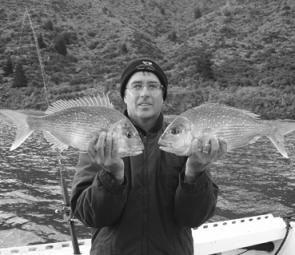
Kim Martin with a brace of snapper that are ready for the pan.
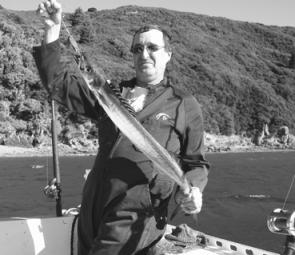
Barracouta are an aggressive species that readily attacks metal lures cast and retrieved or dropped to the bottom and ripped back top the top.
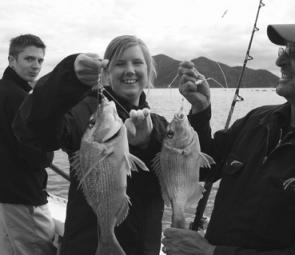
Captain Rob with a happy customer. Catching fish is what keeps charter businesses going and Captain Rob does it very well.
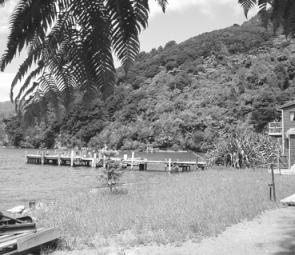
Te Rawa Resort was a great base for the fishing excursion and I’d highly recommend it.
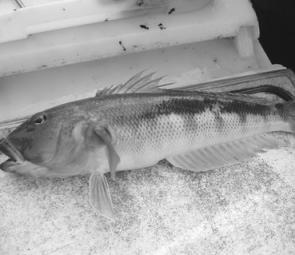
Blue cod are a tasty and exotic fish for most Queenslanders.




